15 Essentials to Pack for Olympic National Park (All Year!)

Packing for a trip to Olympic National Park can feel like prepping for every season in one week.
With weather that can swing between fog, wind, sun, and rain in a single day, it’s tough to know what to bring—and easy to overpack.
➥ I’ve explored this park for over a decade, and these are the fifteen items I bring year-round, whether I’m hiking alpine ridges, rainforest trails, or coastal beaches.
I’ll also show you how I layer my clothing and gear in all conditions—starting with my softshell jacket, my most essential item—so you can do the same!
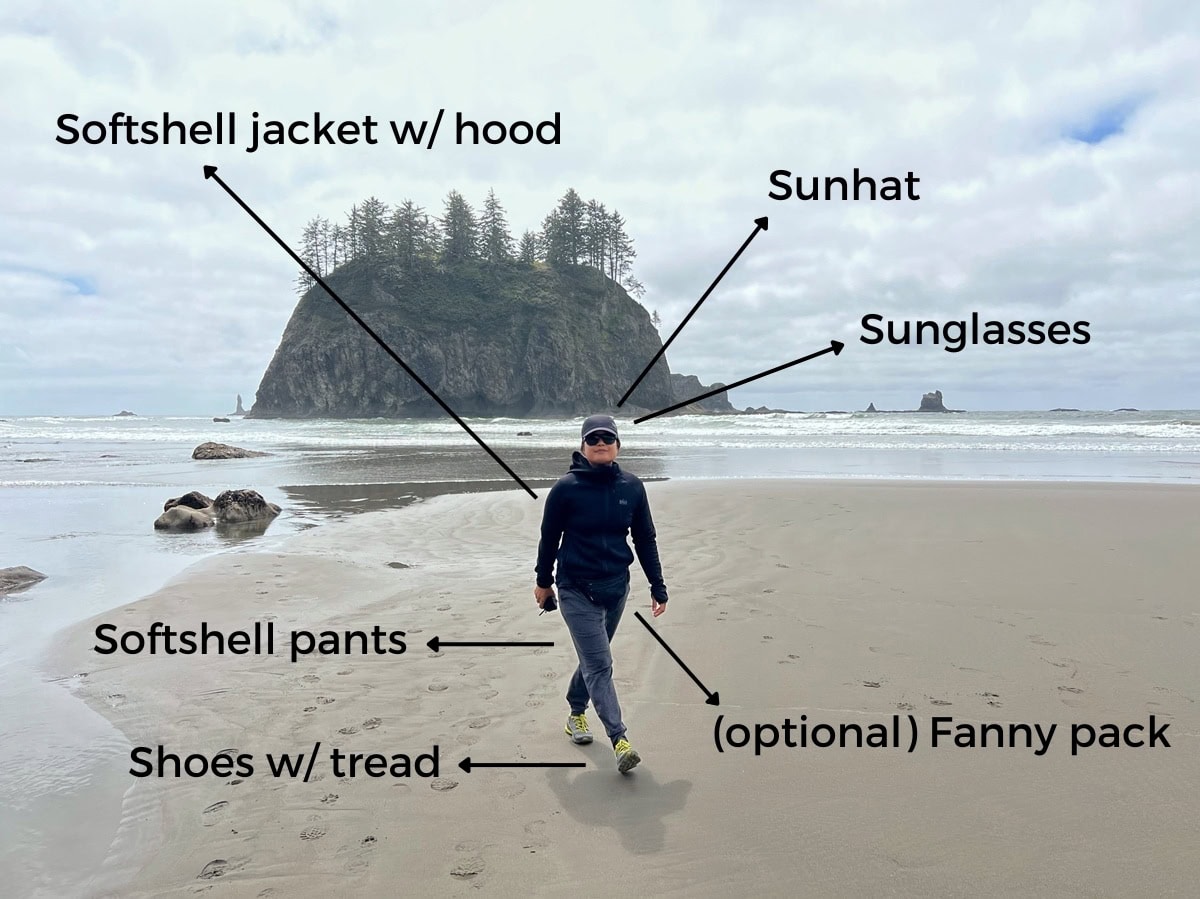
What to Wear to Olympic National Park
The perfect outfit for an Olympic National Park vacation consists of a moisture-wicking top, a softshell hooded jacket, comfortable pants, shoes with good tread, and sun protection.
This outfit, captured in my photo above, works year-round with a few adjustments:
- In summer, I swap the jacket for a lightweight sun hoody and keep my jacket in my pack.
- In fall or spring, I wear the full outfit shown in the photo, add a rain jacket if needed, and keep rain pants in my pack.
- In winter, I wear thicker softshell pants, layer an insulated jacket over my softshell, and add rain gear on top if it’s wet or snowing.
I’ll break down what to wear on your feet—and what to keep in your backpack—just ahead.
The list below is for day hikers and first-time visitors staying in hotels, lodges, or vacation rentals who want to know what to pack for Olympic National Park. It’s not a checklist for camping gear or backpacking.
Get the Printable Packing List
If you’d rather print a list to checkoff while you pack, I’ve got you!
Apparel
Ask any local, and they’ll tell you to bring layers. The right layering system can make the difference between cutting your hike short or staying out longer, even if the wind picks up or the rain starts to fall.
Below are the exact layers I wear to stay dry and comfortable morning to night.
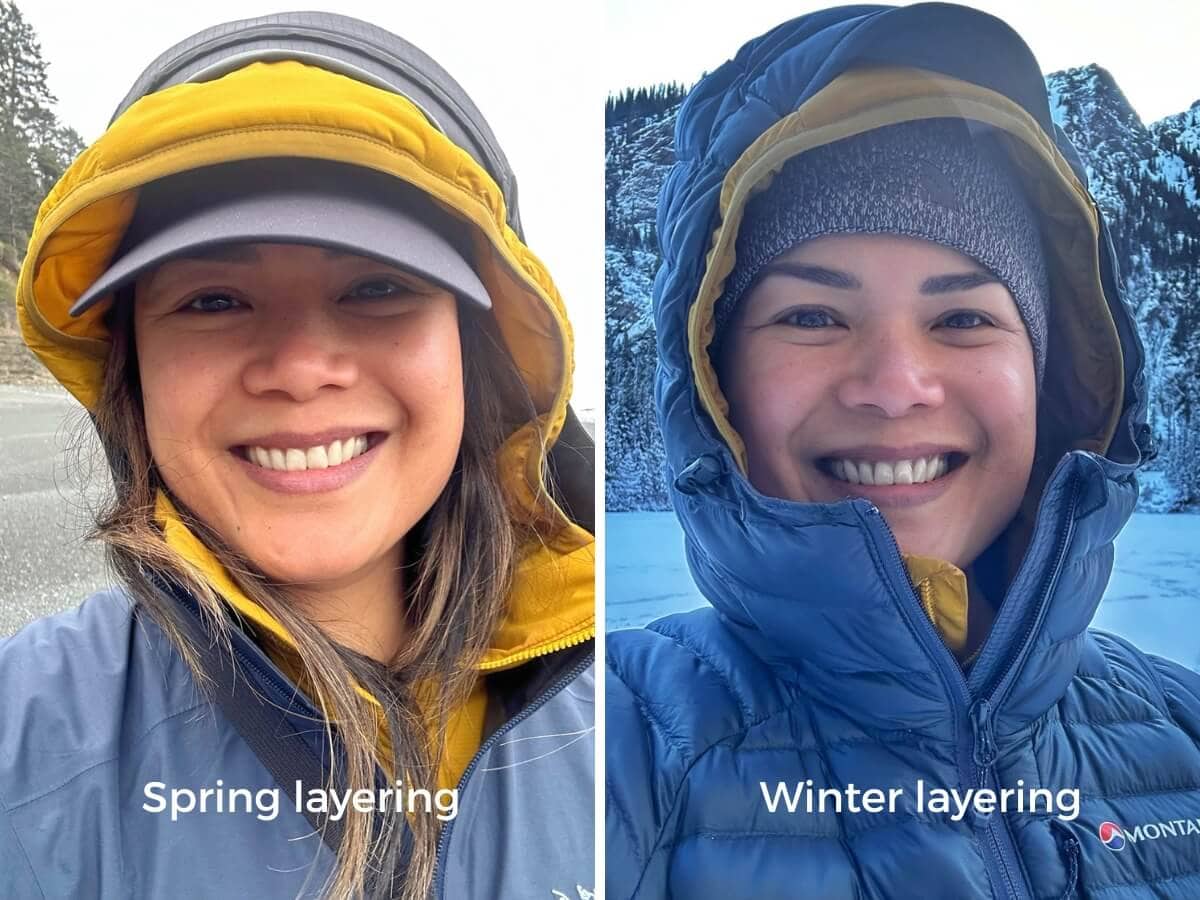
1. Moisture-Wicking Top
I wear a moisture-wicking long-sleeve top year-round, even in summer. It keeps the sun off my skin and saves me from having to constantly reapply sunscreen.
In cooler months, I wear a lightweight top without a hood, and in summer, I wear a sun hoody with UV protection to keep my neck covered in the sun.
This base layer is the foundation of a “layering system.” It helps regulate my body temperature and keeps me comfortable whether it’s raining or I’m sweating on the trail.
2. Softshell Jacket
My love for softshell jackets cannot be overstated. I own three, but my go-to is the Arc’teryx Atom Hoody. It’s breathable, warm without overheating me, and offers light rain and wind protection.
I pack it on every hike, all year long. It compresses easily (I smush it into my backpack) and zips comfortably over my base layer when I stop for breaks or lunch.
This essential layer lets me keep going when the wind picks up or the weather shifts.
The Arc’teryx Atom Hoody is an investment—but if you’re not outdoors all the time, there are excellent budget-friendly softshells that perform well, too.
★ WINTER TIP
Add an insulated jacket over your other layers to stay warm. Choose one that’s fitted enough to wear under a rain jacket if needed.
Layering is better than wearing a bulky parka in Olympic in winter. You’ll have more flexibility to adjust in changing weather.
3. Rain Jacket
It’s the Pacific Northwest, so pack a rain jacket! I keep a Gore-Tex hardshell in my backpack year-round. I’ll leave it in the car in the summer if the forecast looks clear.
You may not need it every day, but when that unexpected downpour hits, you’ll be glad you brought it.
On a Hurricane Ridge hike, I layered my sun hoody, softshell, and rain jacket to stay warm when the wind picked up at higher elevations. That outer shell made all the difference.
Look for a jacket that’s waterproof, not just water-resistant. Mine has zippers under the armpits, so I don’t overheat while hiking in the rain—an excellent feature for regulating body temperature.
4. Softshell Pants
I always wear softshell pants when adventuring—they’re breathable, flexible, and dry quickly if they get wet.
I’ve tested several over the years, but my Vuori pants are the ones I wear most (especially for shorter hikes and long drives).
For more rugged hiking trails, I reach for my Arc’teryx leggings. They’re lightweight, yet durable against brush and rock, and layer easily under rain pants when needed.
Leave the cotton and denim at home. Synthetic softshells are the best choice for staying dry, comfortable, and trail-ready.
Footwear
The right shoes can be the difference between reaching the waterfall or viewpoint—or turning back when the trail gets muddy and slick.
Olympic’s trails are often rocky, root-filled, and uneven. Here’s what I wear to stay surefooted and blister-free.
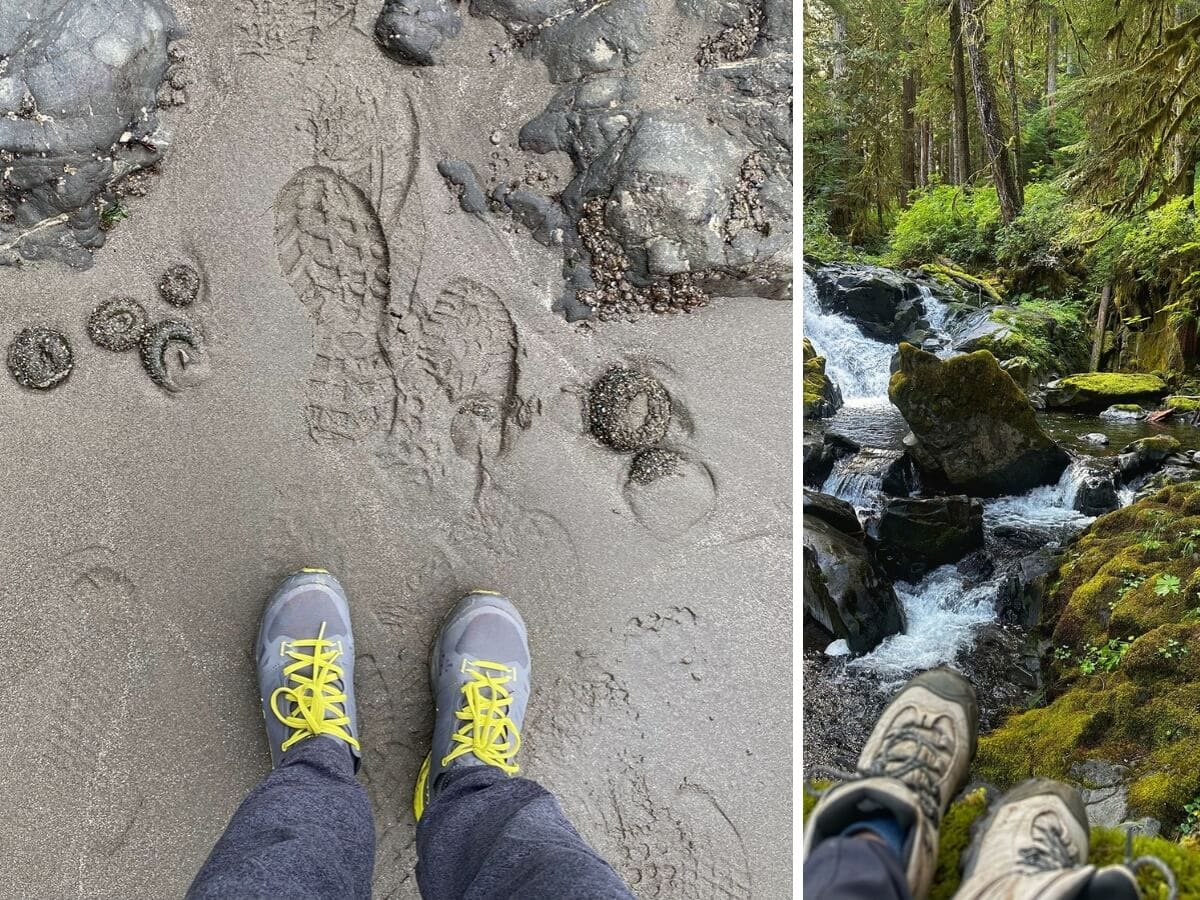
5. Moisture-Wicking Socks
Comfortable feet make or break a hike—and socks play a bigger role than most people realize.
I hike in Wrightsocks, which uses a two-layer construction to reduce friction and manage moisture. I’ve worn them on multi-day trips and never gotten a blister.
They wear out a little faster than I’d like (even with hand washing), but when that happens, I repurpose them as everyday socks.
6. Hiking Boots or Trail Runners
Hiking boots have been my go-to, especially on high-elevation trails with rocky terrain. For shorter trails and beach hikes on summer days, I often switch to trail runners for a lighter, more flexible option.
Closed-toe, sturdy shoes with good tread are key—even on the beach. I learned this the hard way on Rialto Beach when pebbles kept getting stuck in my Tevas.
That said, it’s worth tossing water shoes in your backpack for spots like Point of Arches. I couldn’t cross shallow water because I’d left my Tevas behind.
If you’re unsure about what footwear to bring, you’re not alone.
I recently made the switch from boots to shoes and can now say with confidence that hiking shoes are the all-around best shoes for Olympic National Park.
★ WINTER TIP
I wear fleece-lined Icebug boots with gaiters layered over them to keep out snow and slush. I’ll also wear microspikes if the trail is icy or packed with snow.
Accessories
These aren’t just nice to have—they’re the things that keep a fantastic day from turning into a frustrating one.
From sun protection to hydration, these small essentials make a big difference in how prepared, comfortable, and safe you’ll feel on the trail.
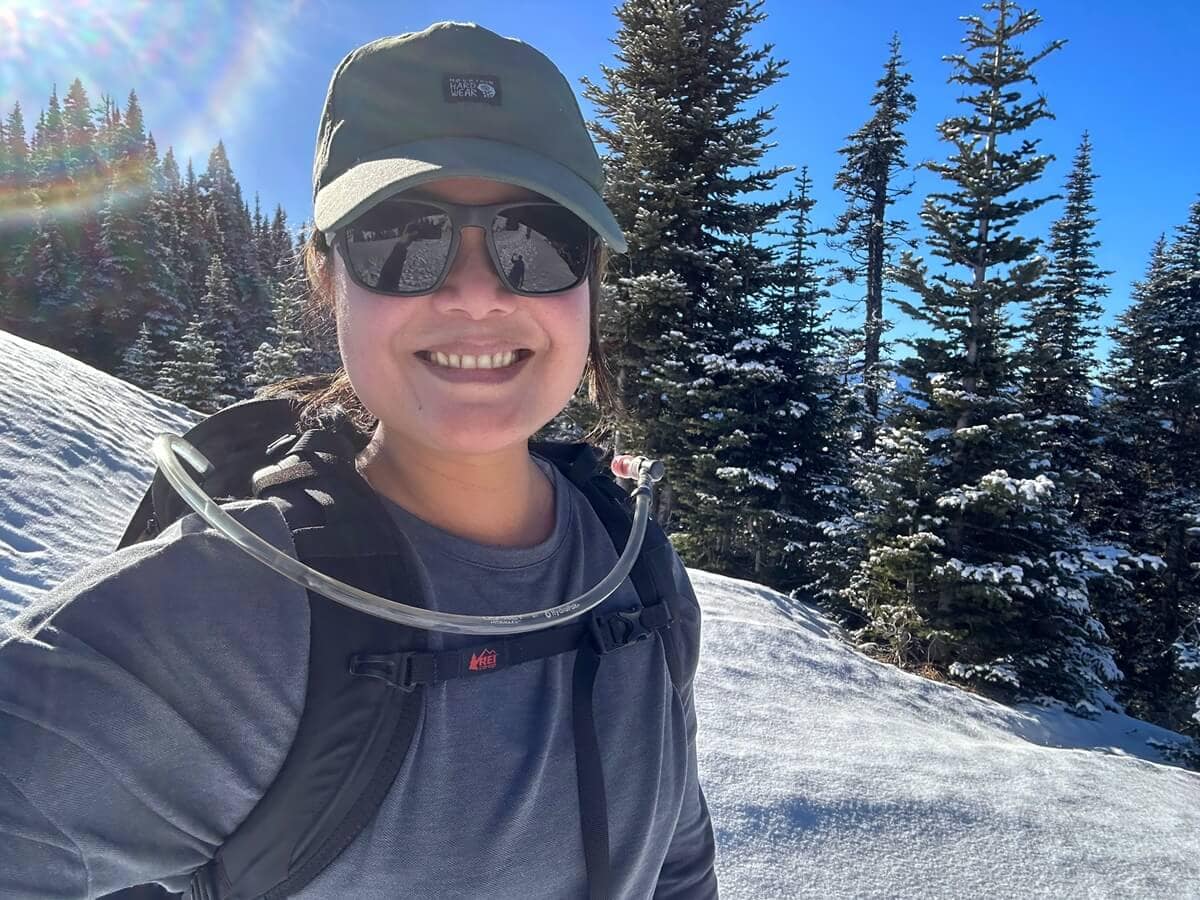
7. Sun Protection
Don’t underestimate the sun, even on cloudy days.
I always wear a sun hat and sunglasses and use a sun stick for quick, easy application on my face. It’s lighter and less messy than liquid sunscreen, especially when reapplying on the trail.
I like the face stick from Raw Elements because it’s small enough to stash in my hip belt for easy access while hiking.
8. Backpack w/ Hip belt
I always wear a backpack on hikes longer than an hour. It carries water, snacks, extra layers, and my first aid kit.
But the real value is that it keeps my hands free when navigating driftwood and rocky trails and using my trekking poles.
Look for one with a hip belt to shift the weight off your shoulders. You’ll stay more comfortable and go farther with less fatigue, and you can stash snacks in the hip belt pocket for quick access.
9. Trekking Poles
I always hike with trekking poles. I started using them years ago while dealing with patellofemoral pain—and even after my knees improved, I never stopped.
They’re essential on steep descents, where they reduce impact and help me stay stable when the trail gets slick or my legs tire.
If you’ve ever felt shaky near the end of a hike, you’ll know how helpful it is to have that extra point of contact with the ground.
10. Hydration Bladder
You don’t realize you need a hydration bladder until you use one. I love the convenience of sipping water whenever I want without stopping or digging for a bottle.
But it’s not just about convenience. It’s the best way to stay consistently hydrated, especially on longer or hotter summer hikes.
If you tend to forget to drink water until it’s too late, hydration bladders are a game-changer.
11. Headlamp w/ Extra Batteries
I once made the mistake of leaving my headlamp behind on a hike to Shi Shi Beach. Even though it wasn’t dusk, the forested trail back to the car was much darker than expected.
I’m a “ten essentials” evangelist, so I believe even casual hikers should carry one—along with extra batteries.
It’s a small item and can make all the difference if your hike runs longer than planned, especially in the deep woods where light fades fast.
12. First Aid Kit
I always carry a small kit with moleskin, blister patches, allergy meds, and personal medications.
Ibuprofen and Tylenol are the first aid supplies I replenish most often.
Whether it’s a sore knee, unexpected headache, or mild reaction to something on the trail, a few basics can go a long way toward saving the day and helping you keep hiking.
13. Bug and/or Bear Spray
I despise insect repellent—but sometimes, it’s necessary. Nothing ruins a peaceful moment by a lake or river faster than bugs swarming around your face.
If you’re hiking in remote areas where bear spray is recommended, bring it and keep it within easy reach. Most importantly, make sure you know how to use it.
14. Navigation Tools
Even on well-marked trails, I always carry a GPS device—or, at the very least, downloaded maps and a portable charger.
Cell service is spotty throughout the park, and navigation tools can be a lifeline if the weather rolls in or you lose track of time.
Here are the apps and maps I use:
- AllTrails – download offline maps before you go
- NPS App – great for current alerts
- Tide Chart – essential for exploring tide pools at Hole-in-the-Wall or Beach 4
Bonus Item
Not essential—but worth it. A seating pad or chair lets you pause, take in the view, and enjoy where you’ve hiked to.
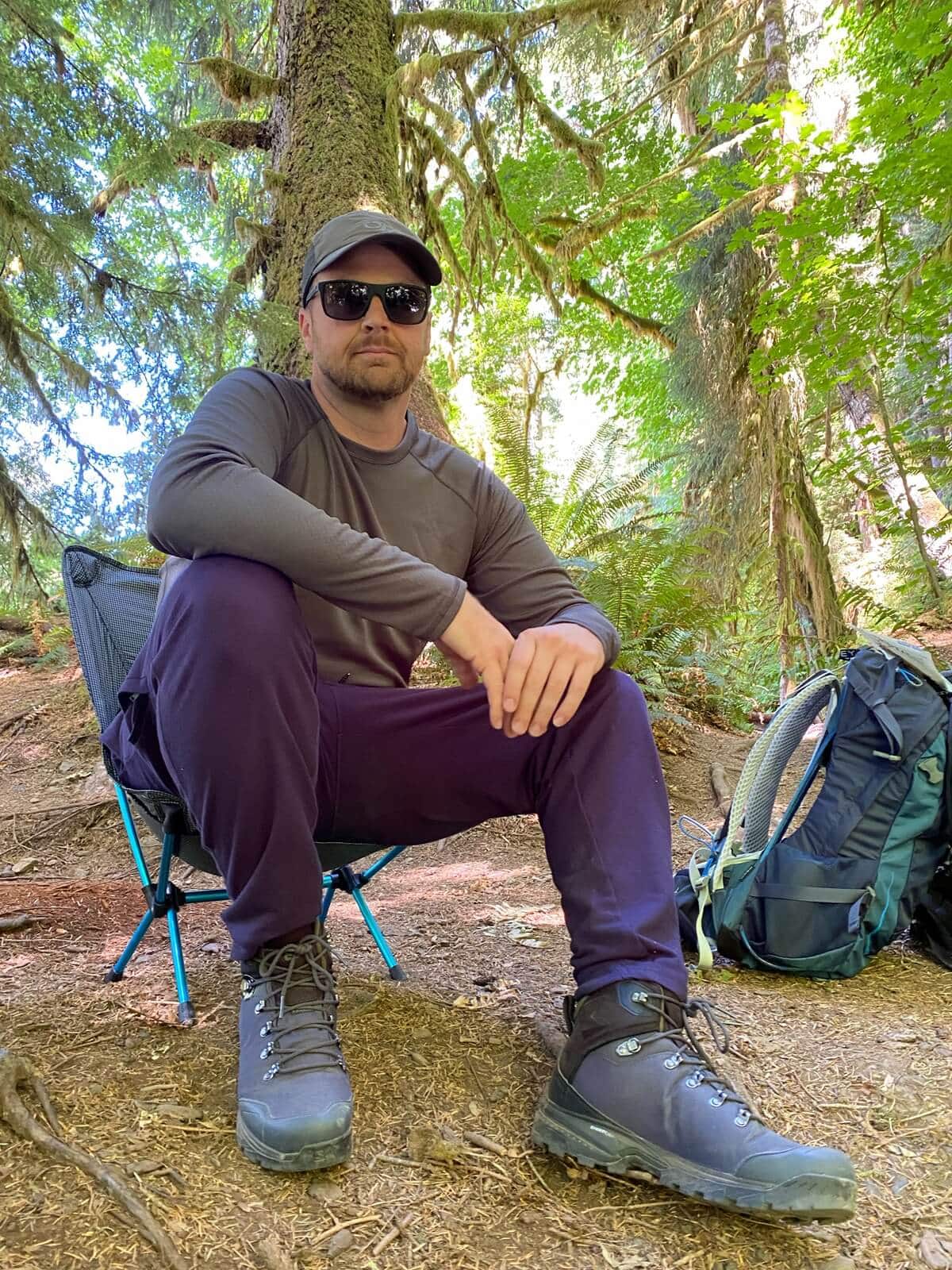
15. Seating Pad or Chair
I’ve never regretted packing a lightweight chair or seating pad, especially when it’s time to eat lunch or linger at the destination.
We used our Helinox Chair Zero in the Hoh Rain Forest, which made the experience so much better. My husband, Colby, was able to relax and enjoy the view at Mineral Creek Falls, while I sat on my pad.
The chair weighs under a pound, packs down small, sets up fast, and makes it easier to savor the moment instead of heading back too soon.
Pack Smart for Olympic National Park
After more than a decade of traveling and hiking on the Olympic Peninsula, I’ve learned that having the right gear allows you to truly enjoy where you are.
Even Colby—who isn’t a gear junkie like me—looked at me mid-hike and said, “This shirt magically knows what temperature I am and adjusts.” And later: “My feet aren’t sweaty.”
He’s not a hiker, but we hiked comfortably over six miles that day.
Use this list to set yourself up to stay out longer on park trails, reach the best viewpoints, and avoid getting cold, wet, or blistered.
RELATED TRIP PLANNING POSTS:
➥ Plan Your Perfect Trip to Olympic National Park (Start Here!)
➥ 7 BEST Towns Near Olympic National Park Worth Visiting!
➥ 21 Places To Stay Near Olympic National Park (By a Local!)
➥ 10 BEST Summer Day Hikes on the Olympic Peninsula
➥ 13 BEST Beaches on the Olympic Peninsula
➥ 2 Day Olympic National Park Itinerary (Easy & Efficient!)
➥ Olympic National Park Day Trip (Best 1-Day Itineraries!)
➥ What to Pack for Olympic National Park (All Year!)
➥ Best Shoes for Olympic National Park Trails, Towns & Beaches
➥ Olympic National Park Visitor Center: 7 Reasons to Stop
SEASONAL TRAVEL POSTS:
➥ Fall in Olympic National Park (11 Best Things to Do!)
➥ Winter in Olympic National Park: 7 Things to Do + What’s Open
Skip the guesswork, stress, and hours of research—let me help you plan your itinerary!


